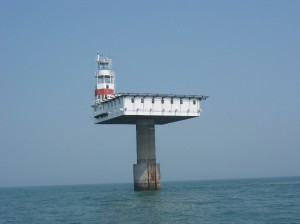Summary: Dover to Brighton. 72.2M in 11 hours and 35 minutes. Not an exciting trip. Very little wind and a significant proportion under motor.

We set off at 5am, making sure to get out of the Glanville Dock before they close the gates around four and a half hours after HW Dover. It looked like there was some breeze, but once outside the harbour there was relatively little. We caught a loose fishing float and towed that behind us for a while, but slowing down and cutting the engine seemed to allow it to drop, so it was probably just caught around the keel. We managed to sail at first for about 45 minutes, but the wind died and on went the motor. Then off again as the wind came in a little, then on again, then off again and ….. Basically this was the story of the day. Sometimes there was 10-12 knots of breeze and we had a nice sail and then it died again and we had to motor. Add to that the fact that there was only 3-4 miles visibility so we didn’t even see the shore for most of the day and you can see it was some fairly ‘boring bimbling to Brighton‘!
The two high points of the day? First Dungeness which as anyone knows (!) is a cuspate foreland created primarily by longshore drift. Behind it is a low lying area of land – Romney Marsh. It is an important habitat and an SSSI. Close by at Denge are also a series of acoustic mirrors left over from a listening experiment during WWII.
The second high point was the Royal Sovereign Tower. This tower was completed in 1971 and replaced the Royal Sovereign lightship which marked the shoals from 1875 onwards.
The tower was built of concrete in two sections on Newhaven beach. The base and vertical pillar were floated into place and then sunk onto the seabed. The cabin, providing accomodation for the lighthouse keepers was then floated on top of the pillar and secured. The pillar had a telescopic section which was then lifted to move the cabin 13 metres above sea level – higher than any waves should come. It was automated in 1994 and so has not had any permanent residents since then. The light and fog signals are now monitored and controlled from Harwich.
From there we managed to sail a little before the wind headed us and died and despite trying to tack round Beachy Head, we eventually gave up and motored the rest of the way to Brighton arriving around 4.45pm. In Brighton we saw the Boat Project – a project from the Cultural Olympiad. We should get a closer look when we get to Portland as it will be at the Passage to Portland event.

